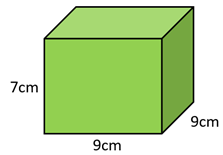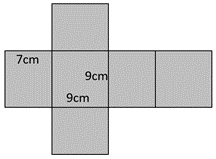Purpose
The purpose of this activity is to support students in finding the volumes of cuboids by measuring the edges in centimetres, or by interpreting diagrams in which the dimensions are given in whole numbers of centimetres. Students also use cubic centimetres (cm3) to represent volume.
Achievement Objectives
GM3-2: Find areas of rectangles and volumes of cuboids by applying multiplication.
Required Resource Materials
- Carboard boxes with dimensions that are whole numbers of centimetres
- Rulers
- Unit place value blocks – 1cm3
- Calculators
Activity
- Show students a cardboard box with whole number dimensions, such as 9cm x 9cm x 7cm.
Hold up a 1cm3 cube (Place Value Block).
I want to work out the volume of this box. I am using cubic centimetres like this.
How can I work out the number of cubic centimetres that will fit into this box?
Let students discuss a strategy to try. This might include the following:- Considering that the side lengths must be measured in centimetres.
- Recognising that volume is the amount of space enclosed by the box.
- Using arrays to simplify the counting of cubic units.
- Using multiplication, such as9 x 9 x 7 = 567cm3.
- Discuss the strategies students suggest. As much as possible act out the placement of cubic centimetres along the interior edges of the box. Encourage the students to visualise the structure of the 3-dimensional array created within these cube borders.
- Ask students to measure the dimensions of the box in centimetres. Draw a cuboid diagram and record the measurements.

Record the calculation as 9cm x 9cm x 7cm = 567cm3, pointing to the dimensions as you record the relevant measurement.
Discuss the use of the exponent 3 which means that the units are 1cm long in each of three dimensions: length, height, and depth.
Introduce relevant te reo Māori kupu, such as the rōrahi (volume), and poro-tapawhā hāngai (cuboid).
- Pose similar problems using boxes with dimensions given in whole numbers of centimetres. Record the volumes of the boxes using equations as above. You might have students explore and record these volumes in pairs. Consider pairing students to encourage tuakana-teina. Alternatively, it may be appropriate for students to continue to work with the teacher, or to work independently.
Together, use the volume calculations to put the boxes in order by volume, from smallest to greatest.
Note that 3-dimensional objects can be deceiving: some boxes look bigger than they are and some look smaller than they are.
- Present another box and ask students where in the sequence of volumes they think it should be. Tell them to direct you how to calculate the volume of the box. Decide collectively where in the order the box should be.
Next steps for extending learning
- Pose problems where the students create cuboids of given volume. Do not stipulate that the dimensions must be whole numbers of centimetres as that will happen naturally. Some students may challenge themselves by experimenting with decimal dimensions.
Two ways students can create the cuboids are:- Making models with connecting cubes. These cubes are usually 2cm x 2cm x 2cm so the target volumes should be multiples of eight.
- Creating nets and building the boxes from flat patterns. This makes the task more complex but includes elements of geometry, particularly spatial visualisation. Students need to visualise which edges on the net meet to form edges on the box.

Add to plan
Level Three